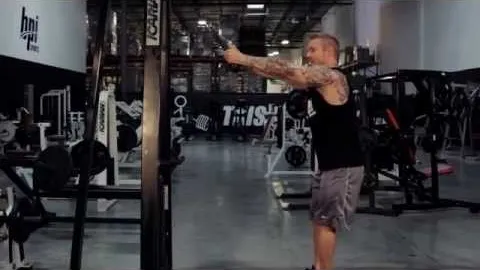
In the world of strength training and bodybuilding, the quest for a well-defined and powerful physique is never-ending. And if you're looking for an exercise that can help you achieve both strength and definition, look no further than the low cable pull.
The low cable pull is a compound exercise that primarily targets the muscles in your back, specifically the latissimus dorsi and the rhomboids. It involves pulling a cable attached to a weight stack low to the ground while maintaining proper form and control throughout the movement.
Strengthens the Back Muscles: The low cable pull is an excellent exercise for strengthening your back muscles, particularly the lats and rhomboids. These muscles are crucial for maintaining good posture and overall back health.
Improves Posture: Many people suffer from poor posture due to weak back muscles. By regularly performing the low cable pull exercise, you can strengthen your back muscles, improving your posture and reducing the risk of back pain and injuries.
Enhances Upper Body Definition: One of the primary goals of weight training is to build muscle definition. The low cable pull targets the muscles in your back, helping to create a well-defined and sculpted upper body.
Engages Multiple Muscle Groups: The low cable pull is a compound exercise that engages not only your back muscles but also your biceps, forearms, and core. This makes it an efficient exercise for working multiple muscle groups simultaneously.
Follow these steps to perform the low cable pull exercise correctly:
Position yourself: Stand facing the cable machine with your feet shoulder-width apart, knees slightly bent, and a slight forward lean from your hips. Grab the handles or attachments with an overhand grip.
Maintain a neutral spine: Engage your core muscles and maintain a neutral spine throughout the exercise. Avoid excessive arching or rounding of your back.
Pull the cable: Initiate the movement by pulling the cable towards your chest, focusing on squeezing your back muscles. Keep your elbows close to your body, and as you reach the fully contracted position, squeeze your shoulder blades together.
Controlled release: Slowly release the cable back to the starting position, keeping tension on your back muscles throughout the movement.
Repeat: Complete the desired number of repetitions, aiming for proper form and control on each repetition.
To maximize the effectiveness of the low cable pull exercise, consider the following tips:
Gradually increase the weight: Start with a weight that allows you to perform the exercise with proper form and control. As you become more comfortable and stronger, gradually increase the weight to continue challenging your muscles.
Focus on mind-muscle connection: Concentrate on the muscles you intend to target during the exercise, specifically your back muscles. Visualize and feel the muscles contracting as you perform the movement.
Vary your grip: Experiment with different grip variations, such as wide grip, narrow grip, or neutral grip, to target different areas of your back and engage different muscle fibers.
Incorporate different angles: Adjust the cable attachment height to perform the low cable pull from different angles. This variation will recruit different muscles and challenge your body in new ways.
Maintain proper form: Focus on maintaining proper form and control throughout the exercise. Avoid using momentum or relying on other muscle groups to perform the movement.
While the low cable pull exercise is generally safe, it's essential to keep the following safety considerations in mind:
Start with a proper warm-up: Before performing any exercise, warm up your muscles with dynamic stretches and light cardio to reduce the risk of injury.
Use appropriate weight: Choose a weight that allows you to complete the exercise with proper form and without straining or compromising your technique.
Listen to your body: If you experience any pain or discomfort during the exercise, stop immediately and consult with a fitness professional or healthcare provider.
Beginners should seek guidance: If you're new to the low cable pull exercise or strength training in general, it's advisable to seek guidance from a certified fitness professional to ensure you're performing the exercise correctly and safely.
When it comes to building back strength and definition, the low cable pull exercise is a highly effective option. By incorporating this compound exercise into your fitness routine, you can strengthen your back muscles, improve your posture, and develop a well-defined upper body. Remember to follow proper form, gradually increase the weight, and listen to your body to achieve optimal results. So, grab those cable handles and start pulling your way to a stronger and more defined back!
If you're looking for a gym, fitness club or yoga studio, you've come to the right place.
You can find information about gyms in your area. Browse catalog of gyms and find gyms with classes which are you looking for.
On gym page you can find simple information like address, phone or website. You can find list of available classes. You can check availability of personal training or small group classes. On place page you can also see information about open hours.
You can find gyms near you with amenities, courts, studios and equipments.
Use our map to find gym at your city or district.
In Gym Navigator you can find list of exercises with movies for many body parts.
You can browse exercises catalog and find exercises the best of you.
You can also find exercises grouped into workout plans, which you can use to improve you body. Each routine show you exercises one by one and give you possibility to count you progress and count down rest time.